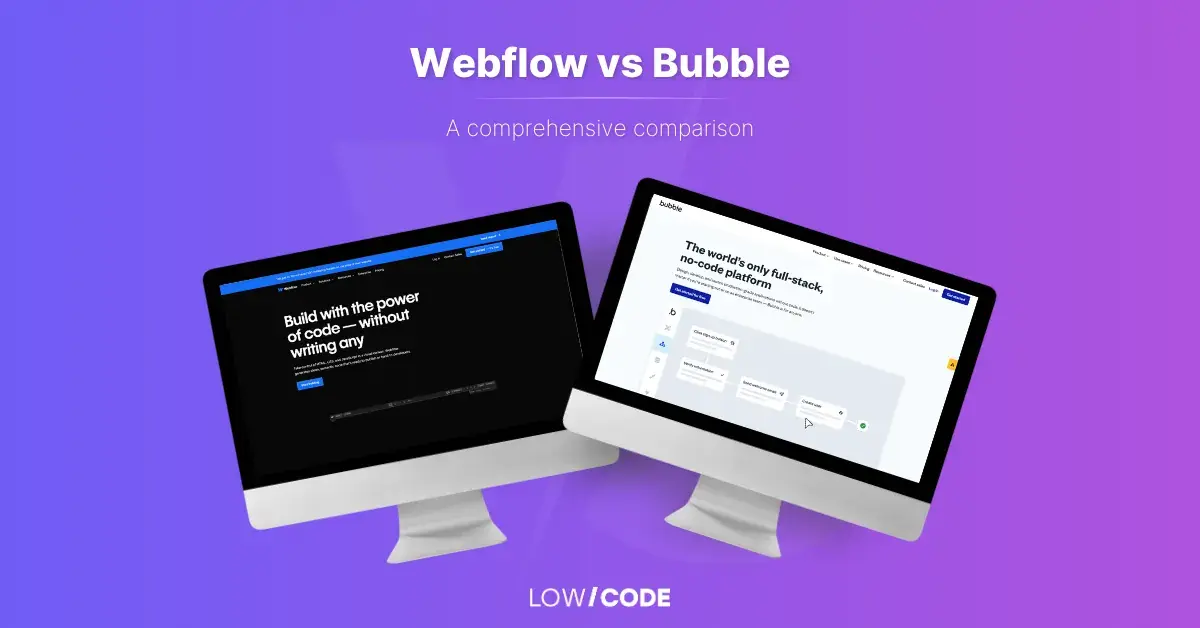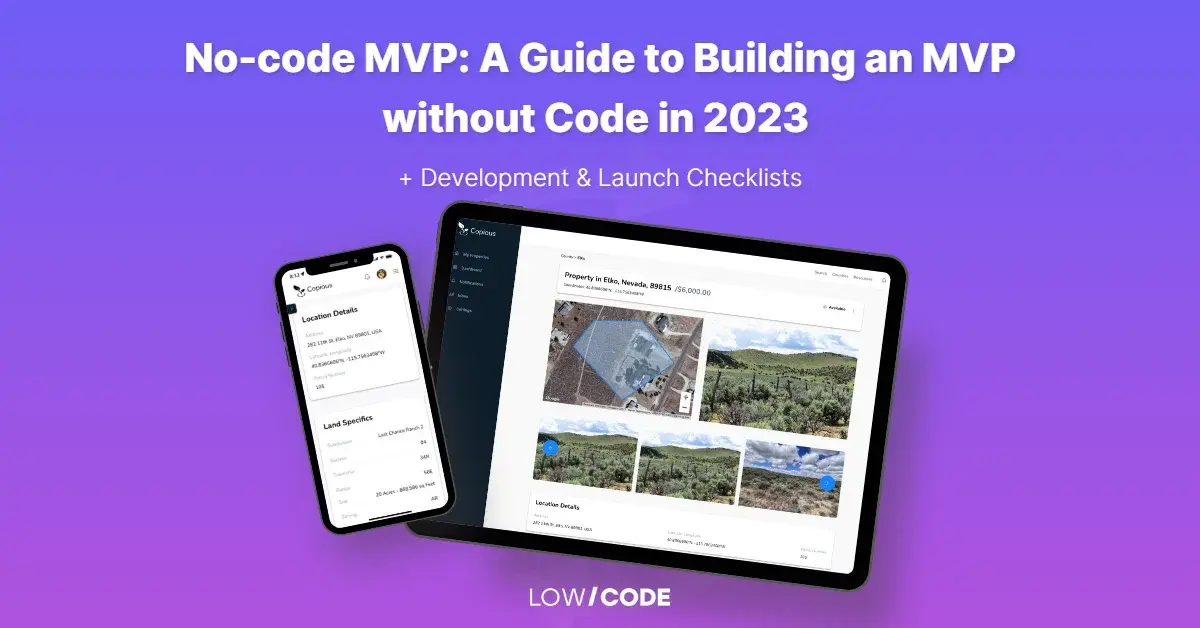
No-code MVP: A Guide to Building an MVP without Code in 2024 + Development & Launch Checklists
In today's fast-paced world, the concept of a Minimal Viable Product (MVP) has gained immense popularity. An MVP is a simplified version of your product that includes only the core features necessary to solve a specific problem. It serves as a valuable tool for entrepreneurs and businesses to validate their ideas, understand their target audience, and assess the viability of a product.
But what exactly is a "no-code" MVP? It’s an MVP that is created using the visual interface, drag-and-drop tools, and pre-built components provided by no-code platforms. The focus is on rapidly prototyping and building functional prototypes or early versions of a product that can be tested and validated with users, without the need for extensive coding. While it still requires thoughtful planning and a solid understanding of your product vision, the use of no-code tools can significantly reduce the technical barriers and complexities traditionally associated with coding.
Throughout this guide, we will explore the benefits and advantages of building an MVP using a no-code approach. We'll discuss how leveraging no-code tools can streamline the development process, facilitate rapid iterations, and empower you to bring your ideas to life with greater efficiency. By the end, you'll have a clear understanding of how a no-code approach can enhance your MVP development journey. So, let's dive in and discover the exciting possibilities of building an MVP without code!
Start with Market Research
To kickstart your MVP development journey, begin with comprehensive market research. Just like any other app, understanding your market is key. Take the time to analyze your niche and identify the main competitors. Delve into their target audience and study their strategies. This research will provide valuable insights into existing solutions, marketing approaches, and user preferences.
Learn about the solutions already available and the needs they address. This knowledge allows you to identify gaps and opportunities where your MVP can shine.
Analyze the competition
Take a close look at other companies that have already launched their products in your target market. Study the solutions they implemented, so you can identify the gaps and opportunities that exist. Understanding what the market needs and what users are looking for will guide your MVP development process.
Geographically segment the customer base
Consider geographically segmenting your customer base. Different regions may have distinct preferences, needs, and pain points. When you successfully recognize these variations, you can tailor your MVP to specific market segments, enhancing its relevance and appeal.
Find the motivation behind a purchase
To create a compelling MVP, it's important to uncover the motivation behind a purchase. Dive deep into the reasons why users would choose your product over others. Understanding their motivations will enable you to design features and functionalities that align with their desires.
Study market trends and potential user pain points
Recognize the main challenges faced by the market today. Although you may not be able to solve every issue, addressing key pain points presents an opportunity to create a solution that resonates with users.
Understand the target audience's demographics and behavior
Focus on knowing who your future buyers are, so you can tailor your product to satisfy their needs and increase the chances of a successful launch.
Start by conducting thorough research to uncover key demographic information about your target audience. This includes factors such as age, gender, location, occupation, and interests. Understanding these demographics will allow you to apply best practices and create a product that resonates with your specific target market.
Beyond demographics, it's essential to delve into the behavior of your target audience. Explore their preferences, habits, and pain points. What are their goals and aspirations? What challenges do they face in their daily lives? Gain insights into their behavior so you can design an MVP that addresses their specific needs.
Define the Problem Statement
Conduct market research to identify the main user
Before diving into MVP development, conducting thorough market research to identify your target users is essential. Gain insights into their characteristics, preferences, and needs. This research allows you to understand your main user and ensure that your MVP aligns with their expectations.
Determine a clear problem your no-code MVP will solve
Identify a specific pain point or challenge that your target audience faces and that your MVP aims to address. With a clearly defined problem, you can ensure that your MVP is focused on providing a compelling solution.
Establish your target audience
Define the specific group of people who will benefit from your product the most. Consider factors such as demographics, interests, and behavior to create a detailed profile of your ideal users. Understanding your target audience will guide the development process and help you tailor your MVP to meet their needs.
Validate the problem statement with real users
Engage with your target audience, conduct user testing, and gather feedback to ensure that your MVP genuinely addresses their pain points. Involve real users to gather valuable insights, iterate on your MVP, and improve its effectiveness. This validation process increases the likelihood of building an MVP that resonates with your target audience and provides a meaningful solution to their problems.
Ideate and Prioritize
Map out user flow
Visualize the journey that your users will take when interacting with your product. Identify the key steps and interactions they will go through, from the initial onboarding to accomplishing their goals. Mapping out the user flow helps you understand the user experience and ensure a seamless and intuitive interaction. It also provides a foundation for identifying the necessary features and functionalities that will support the user's journey.

Brainstorm possible solutions and features
Encourage creative thinking and explore different approaches to solve the identified problem. Consider how each solution aligns with your target audience's needs and how it can provide value. Brainstorming helps generate a range of ideas and features that can be further evaluated and prioritized based on their feasibility and impact on the user experience.
Prioritize MVP features
The goal of the MVP is to present the idea and working process of the future app. So you have to make sure you only include essential features.

After brainstorming we recommend that you identify the features that you believe will help you show the value of the MVP. To effectively prioritize them, we recommend categorizing them into distinct groups:
- Must-have features: These are the essential features that are critical for your no-code MVP to function and provide value to users. They directly address the core problem statement and are necessary for the MVP to be viable.
- Should-have features: These features are important but not critical for the initial version of your no-code MVP. They enhance the user experience and provide additional value.
- Could-have features: These features are nice to have but are not necessary for the core functionality of your no-code MVP. They can be considered potential enhancements or additional functionalities that may be included in future iterations based on user feedback and market demand.
- Won't-have features: These are features that you have intentionally decided not to include in your no-code MVP. They may be outside the scope of the initial version or not aligned with the primary problem statement.
This approach allows you to gain clarity and help you define the scope of your MVP, decide which features to move forward with immediately, and still keep future upgrades in mind.
Iterate on your idea with user feedback
Share your initial concept with potential users, gather their feedback, and observe their interactions. Use this feedback to refine and enhance your idea, making it more aligned with user expectations and needs. This iterative approach allows for continuous improvement and optimization of your MVP, resulting in a more user-centered and effective product.
Choose the Right No-Code Platform
Understand your MVP requirements
After defining the features and functionality required for your product, you will have a clear understanding of your customization, integration, and collaboration needs between different tools or development processes. This will help you evaluate popular no-code platforms and tools more effectively, as you can assess whether they offer the necessary capabilities to meet your specific requirements. Your goal is to choose a no-code platform that aligns with your project goals and provides the flexibility and compatibility you need for seamless development.
Evaluate popular no-code tools and platforms
There are several popular no-code tools and platforms available in the market. Take the time to research and evaluate them based on factors such as ease of use, available features, scalability, and pricing. Look for platforms that offer a wide range of pre-built components, templates, and integrations that align with your MVP requirements.

Read reviews and case studies
To gain insights into the performance and reliability of different no-code platforms, read reviews and case studies from other users or businesses. This can provide valuable information about the platform's strengths, weaknesses, and real-world use cases. Explore feedback and comments on the platform's ease of use, support, and overall satisfaction of users who have utilized it for similar projects.
Test multiple platforms with free trials or demo versions
To truly gauge the suitability of a no-code platform for your MVP, you can take advantage of free trials or demo versions offered by the providers. This allows you to get hands-on experience with the platform's features and functionalities and assess its ease of use and compatibility with your project requirements.
Consider the platform's community and support resources
When choosing a no-code platform, it's important to consider the strength of its user community and the availability of resources to provide assistance and guidance.
Evaluating the platform's user community can help you gauge the level of engagement, collaboration, and knowledge sharing among its users. Additionally, explore the platform's support ecosystem, which may include comprehensive documentation, tutorials, forums, and dedicated support channels.
A supportive community and robust support resources can greatly enhance your experience, knowing that there’s a helpful environment to aid you in overcoming challenges and maximizing your success with the chosen no-code platform.
If you're looking for detailed reviews of popular no-code platforms, check out our platform comparisons to explore the features, strengths, and limitations of different no-code tools available in the market.
Design and Develop Your No-Code MVP
Create a prototype using your chosen no-code platform
Once you have selected a suitable no-code platform, start by creating a prototype that showcases the basic structure and flow of your MVP. Utilize the platform's visual interface and tools to design the key screens and interactions. This prototype will serve as a blueprint for your MVP's development and provide a visual representation of your product's core features and user experience.
.png)
Build your MVP with a focus on core functionalities
When developing your no-code MVP, prioritize the implementation of core functionalities that directly address the problem statement and deliver value to your target audience. Keep your feature set minimal and focus on the essential components that will enable users to accomplish their goals effectively.
Utilize the features and integrations included in your no-code platform
Leverage the features and integrations offered by your chosen no-code platform to accelerate the development process and enhance the functionality of your MVP. Take advantage of pre-built components, templates, and automation tools to save time and effort. These built-in features provide a solid foundation for building your MVP efficiently and effectively.
Explore the platform's integrations with third-party tools and APIs. Integrations with tools such as Customer Relationship Management (CRM) systems offer valuable benefits. Connecting your app to a CRM allows for seamless data synchronization, like ensuring that when a quote is sent from the app, the status is automatically updated in the CRM. This integration enhances workflow efficiency and eliminates manual data entry. Also, integrating your app with popular communication channels like Slack, email, SMS, or calendars, allows you to send timely notifications to users when specific events occur.
For more insights into how no-code and low-code platforms can be utilized for CRM solutions, check out our guide on how to build no-code/low-code CRM.
Furthermore, you can streamline data retrieval by using an API to connect your no-code platform to databases. For instance, in an inventory app, you can scan a barcode and use the integration with the company's internal API to get information about the product.
Through the integration with OpenAI, you'll be able to unlock a wide range of powerful AI-driven capabilities. OpenAI's language models enable natural language processing, sentiment analysis, or even generating dynamic content based on user inputs. You can convert a PDF to text or even extract specific information from the document, such as finding the total price of an item or a due date. Another valuable use case is the ability to record voice notes and convert them to text.
Test and refine your MVP to ensure a smooth user experience
Conduct thorough testing across different devices, browsers, and user scenarios to identify and address any usability issues, bugs, or performance bottlenecks. Gather feedback from real users and iterate on your MVP based on their insights.
Launch and Iterate
Launch your no-code MVP to the target audience
Once your no-code MVP is ready, it's time to launch it to your target audience. Make it accessible to your intended users and gather valuable insights through real-world usage. Consider leveraging marketing strategies and channels to create awareness and drive initial adoption.
- Exercise 'B.M.L.' — Build, Measure, Learn
Embrace the 'Build, Measure, Learn' cycle as a fundamental principle of launching and iterating your no-code MVP. Continuously build new features or improvements, measure their impact through user feedback and analytics, and learn from the results to inform your next iterations.
- Receive feedback and analyze results
Encourage users to provide feedback on their experiences with your no-code MVP. Actively collect and analyze this feedback to gain insights into areas of improvement, identify pain points, and validate your product's value proposition. Leverage analytics tools and user surveys to gather quantitative and qualitative data for a comprehensive understanding.
- Implement updates and improvements based on user feedback:
Use the feedback and insights gathered from your users to drive updates and improvements to your no-code MVP. Prioritize the most impactful changes and iterate on your product to address user needs and pain points. Iteration allows you to refine and enhance your MVP based on real-world feedback.
- Conduct A/B testing and experiments to refine the MVP
Conducting A/B testing and experiments is an essential practice to refine your no-code MVP. In A/B testing, you create two or more variations of your MVP and present them to different segments of your audience. With A/B testing you can measure and compare the performance of different elements in your MVP, such as button placement, color schemes, or even entire user flows.
By running these experiments, you can identify which variation generates better user engagement, conversion rates, or other desired outcomes. This data-driven approach helps you make informed decisions on how to optimize and refine your MVP to maximize its impact and better meet the needs of your target audience.
Measuring Success After Building a No-Code MVP
Measuring the success of your no-code MVP involves tracking key performance indicators (KPIs) that provide valuable insights into its performance. These KPIs serve as measurable metrics to assess the effectiveness and impact of your MVP.

- Word of mouth: Monitor positive referrals and organic growth through user recommendations, as it indicates the satisfaction and value your MVP is delivering to users.
- Engagement: Evaluate user interaction, time spent, and overall satisfaction with your MVP to gauge its level of engagement and user experience.
- Sign-up: Track the number of users signing up for your MVP to assess the initial interest and potential conversion into active users.
- Better client appraisals based on feedback: Measure client satisfaction and feedback to ensure your MVP is meeting their needs and continuously improving based on user input.
- Percentage of active users: Monitor the proportion of users actively using your MVP, as it reflects its ability to retain and engage its audience.
- Client Acquisition Cost (CAC): Evaluate the cost of acquiring new clients to understand the efficiency of your marketing and acquisition strategies.
- Number of paying users: Keep track of the number of users who convert into paying customers, as it directly impacts your revenue generation.
- Client Lifetime Value (CLV): Assess the long-term value and profitability of each customer to understand the overall financial impact of your MVP.
- Churn rate: Measure the rate at which users discontinue or stop using your MVP, as it indicates the effectiveness of your user retention strategies.
To effectively measure the success of your no-code MVP, you must set measurable goals and benchmarks for each KPI. This allows you to track progress, identify areas for improvement, and make data-driven decisions to optimize your MVP's performance and achieve your desired outcomes.
No-Code MVP Examples
FINN - MVP built with Webflow

FINN is a startup that aims to make car ownership fun and sustainable by offering car subscriptions with everything included. It was founded in late 2019 and its goal is to make reservations for cars just as simple as any online purchase. They were able to reach $4 million in annual recurring revenue (ARR) in its first year.
When developing their first version of the website, FINN utilized Webflow, a no-code platform that allowed a non-engineer to create a landing page, product listing page, and checkout page within just one week. By connecting the website to Google Sheets as the database, they were able to gather and manage customer data seamlessly. To handle their data and frequent schema changes, FINN relied on Airtable, another no-code tool. The platform's automation capabilities enabled them to monitor data and trigger specific events when needed.
FINN's success story exemplifies the effectiveness of a pragmatic approach in building a successful no-code MVP. Their decision to steer clear of technical intricacies and not build everything from scratch resulted in significant time and effort savings. Embracing a culture of experimentation, they were able to determine the most effective features and discard those that didn't yield favorable results. Moving forward, they focused on developing customized solutions to scale their operations while maintaining simplicity and efficiency.
Comet - MVP built with Bubble

Comet is a marketplace that connects programmers and data science freelancers with remote job opportunities. Comet's unique selling point centered around its rigorous vetting process for freelancers, ensuring top-notch talent and setting them apart from general freelance platforms like Upwork or freelancer.com. This competitive advantage attracted attention, and Charles successfully secured $2 million in funding from notable European investors.
Comet's founding story exemplifies the transformative potential of no-code tools in democratizing entrepreneurship. Three years ago, fueled by their vision to bridge the gap between freelancers and companies, the founders embarked on a remarkable journey. Despite their limited coding knowledge, they harnessed the power of tools like Bubble, Crisp, and Zapier. Specifically, using Bubble allowed them to rapidly prototype their platform, as detailed in our guide on Bubble.io's capabilities and limitations. This enabled them to attract initial clients within days, all without the need for coding expertise. The accessibility and efficiency of these no-code tools not only propelled their progress but also provided them with a significant competitive edge, saving precious time and resources in the early stages of their business.
Related: Bubble app examples
Related: The top 5 no-code tools for marketplaces
Uhome Reentry - A no-code MVP with LowCode Agency

Uhome Reentry is a solution conceived by Dr. Romeatrius Moss who drew inspiration from her personal experience with home confinement and the challenges associated with re-entering society after incarceration.
UHome Reentry App is designed to provide guidance, support, and a sense of security for individuals navigating the complexities of home confinement, ensuring compliance and helping them successfully fulfill their obligations.
UHome tackles the burdensome paperwork involved in home confinement and the submission process to case managers. The app aims to help users organize their passes, offering reminders and notifications, and assisting in effective time planning for pass submissions in the upcoming weeks.
With almost 200,000 individuals exiting federal incarceration alone each year in the United States, UHome Reentry App fulfills a vital need in supporting individuals as they navigate the challenges of reintegrating into society. The app is in its beta-testing phase with a few dozen users, before doing a national rollout.
Cost and Timeframe for Building a No-Code MVP
How Long It Should Take to Build a No-Code MVP
The timeframe for building a no-code MVP can vary depending on various factors, such as the complexity of the problem being solved and the scope of the MVP. Generally, the development of a no-code MVP is quicker compared to traditional coding approaches.
With the advantage of using visual interfaces and pre-built components, you can accelerate the development process significantly. However, it's important to allocate sufficient time for proper planning, market research, and iterating based on user feedback. While there is no fixed timeline, aiming for a time frame of a few weeks to a few months can provide a reasonable target for building a solid no-code MVP.
Factors Affecting No-Code MVP Development Cost
The cost of building a no-code MVP can be influenced by several factors. These include the complexity of the problem you're addressing, the features and functionalities required, the level of customization needed, and the availability of suitable no-code tools and platforms.
Additionally, factors such as hiring external expertise or investing in training resources can impact the overall cost. It's important to carefully evaluate your budget and consider the trade-offs between cost and the value the MVP will deliver.
Balancing Quality and Speed in the Development Process
While the speed of development is an advantage of no-code tools, it's important not to compromise on quality. Focus on delivering a minimum set of features that effectively solve the problem statement and provide value to your users.
Prioritize user experience, reliability, and performance to ensure a high-quality MVP. While speed is important, it's equally important to test, iterate, and refine your MVP to ensure it meets the needs and expectations of your target audience.
Ready to estimate the cost and timeframe for building your no-code MVP? Try our cost calculator to get an assessment for your project!
Tips for Success and Pitfalls to Avoid
Choosing the Right Problem to Solve
One of the key factors for success when building a no-code MVP is choosing the right problem to solve. Take the time to carefully evaluate different problem areas and select one that aligns with your expertise and has a significant impact on your target audience. When you focus on a well-defined and relevant problem, you increase the chances of creating an MVP that delivers value and resonates with users.
Targeting the Right Segment or Persona
To maximize the effectiveness of your no-code MVP, it's essential to target the right segment or persona. Understand the specific needs, preferences, and pain points of your intended audience. When you tailor your MVP to a specific segment, you are able to create a more personalized and compelling user experience. This targeted approach increases the likelihood of attracting and retaining loyal customers.
Importance of Feedback in Building a No-Code MVP
Feedback plays a crucial role in the development of a successful no-code MVP. Actively seek feedback from your users throughout the development process. By understanding their perspectives, you can refine your MVP, address any usability issues, and make necessary improvements. User feedback also provides valuable insights into the features and functionalities that resonate the most with your target audience.
Balancing Qualitative and Quantitative Feedback
When gathering feedback for your no-code MVP, it's important to strike a balance between qualitative and quantitative feedback. Qualitative feedback, such as user interviews and observations, helps you understand the underlying motivations and emotions of your users. Quantitative feedback, such as surveys and analytics data, provides numerical insights and allows you to measure the impact of your MVP. Both types of feedback will help you fine-tune your MVP effectively.
Managing Stakeholder Expectations and Communication
Effective stakeholder management and communication are vital for a successful no-code MVP. Clearly define roles, responsibilities, and expectations with your team and stakeholders. Regularly communicate progress, challenges, and updates to keep everyone aligned and informed. Foster transparent and open communication to mitigate misunderstandings, address concerns, and ensure that everyone is working towards the same goals.
Avoiding Feature Creep and Overcomplicating the MVP
When building an MVP, you must resist the temptation of adding excessive features and overcomplicating the product. Remember, the essence of an MVP lies in its simplicity and focus on core functionalities. The MVP's purpose is to validate your concept efficiently. Keep it simple and streamlined, so you can iterate quickly, gather feedback, and make informed decisions based on real user data.
Scaling and Future-Proofing Your No-Code MVP
Scale your no-code MVP as your business grows
When it comes to scaling your no-code MVP as your business grows, it's important to consider strategies that accommodate increased demand and evolving requirements. Explore options such as leveraging cloud-based solutions to handle higher user loads, optimizing performance and scalability through efficient database management, and implementing automation to streamline processes. Additionally, consider integrating third-party services and APIs to expand functionality and meet the growing needs of your users.
How to ensure your no-code solution remains adaptable to future changes in the market or technology
To future-proof your no-code solution and keep it adaptable to market and technological changes, there are a few key tips to consider. Firstly, regularly evaluate and update your no-code platform and tools to leverage new features and capabilities. Stay informed about emerging technologies and trends that could enhance your solution or offer new opportunities. Embrace a modular and flexible architecture that allows for easy integration of new functionalities or components. Lastly, maintain a user-centric approach by continuously gathering feedback and insights to inform iterative improvements and adjustments to your no-code MVP.
How to Create an MVP: LCA Experience
At our no-code MVP agency, we are experts in the field of no-code development, and we have valuable insights to share with you. We believe that the rapid progress of no-code technology makes it a suitable choice for approximately 95% of cases when building an MVP. Not only do no-code solutions offer scalability, visually appealing user interfaces, and responsive designs, but they also allow for faster development and iteration.
To increase your chances of success when developing an MVP, remember the golden rule: keep it simple! One common mistake entrepreneurs make is trying to accomplish too much with their initial product. Instead, focus on addressing a single, specific pain point in your market, industry, or business. Conduct thorough market research to ensure that the feature you're targeting is something customers are willing to pay for.
Focus on the M of MVP: embrace minimalism and prioritize simplicity in your product design. Don't fall into the trap of thinking that more features will automatically attract attention. In reality, it can lead to a poor user experience and potential failure. Strive for a simple and user-centric MVP and you will maximize its potential for success and deliver a product that genuinely captures the interest of your target users.
We take pride in helping entrepreneurs like you bring their inspiring app ideas to life. We have guided numerous clients in unlocking the myriad benefits of no-code MVPs. By choosing this approach, you can launch your product faster, gather feedback earlier in the process, and make changes easily based on user input. Additionally, you can achieve all of this with a much lower budget compared to traditional app development, while having complete control over the process.
If you're eager to explore whether no-code is the right approach for your app and need assistance in selecting the perfect tool, we invite you to book a free consultation. With our experience of building over 260 projects, we have the expertise to transform your vision into a successful MVP.
Conclusion
Building a no-code MVP offers numerous advantages and holds great importance in the product development process. It enables businesses to validate their ideas quickly, efficiently, and at a lower cost compared to traditional development methods.
The iterative nature of building an MVP allows for rapid experimentation and gathering of user feedback, ensuring that the final product aligns with market needs and user expectations. Additionally, the no-code approach empowers businesses to accelerate the time-to-market, reduce development complexities, and adapt to changing requirements with ease.
Ultimately, building a no-code MVP enables businesses to test their hypotheses, gain valuable insights, and make informed decisions that drive the success of their product cost-effectively and efficiently.



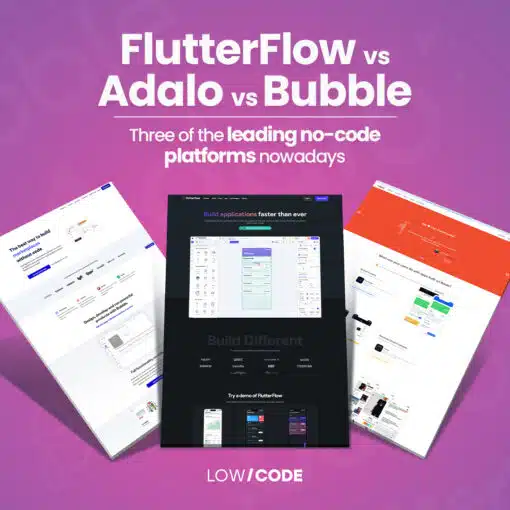
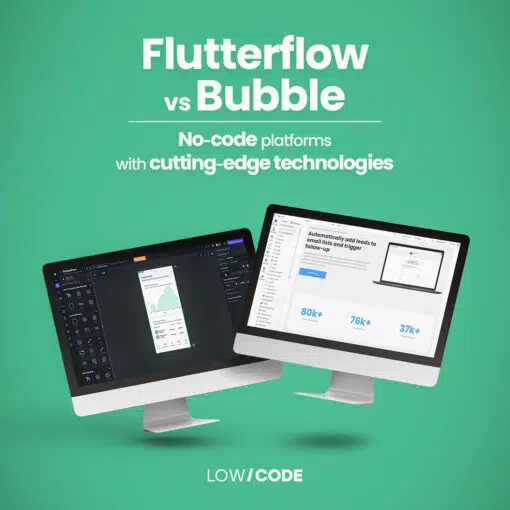

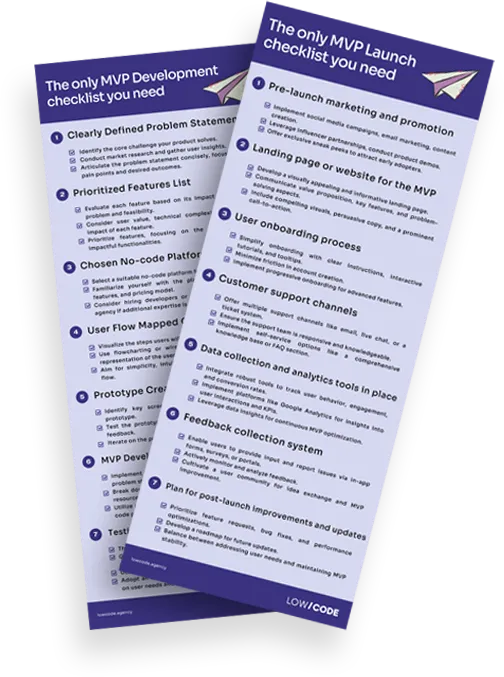
%20(Custom).webp)





.png)
